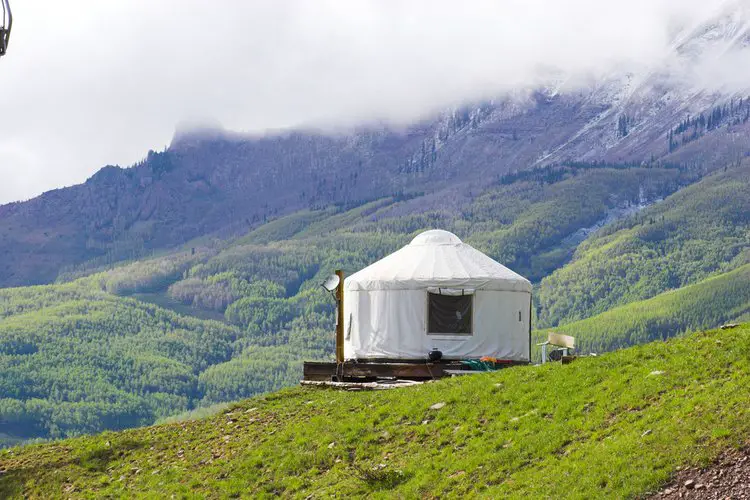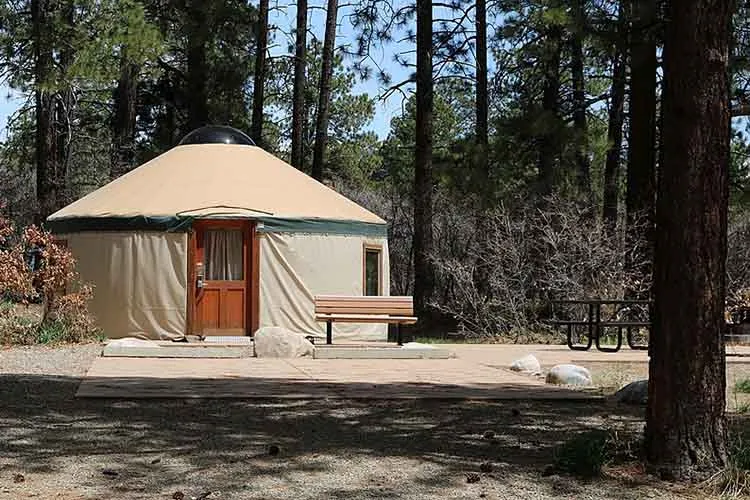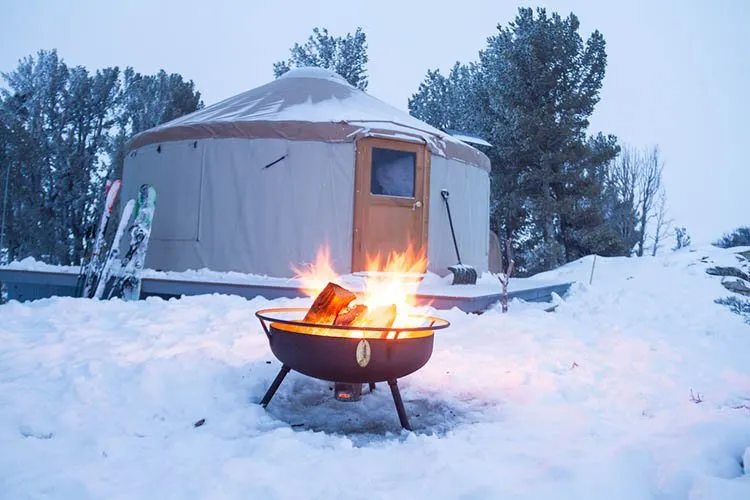Yurts are a popular option for alternative living spaces. We bought a 20-foot yurt in 2007 and love it for seasonal use as a guest house when we have extra visitors at the cabin.
After 15+ years of owning and maintaining a yurt, we’ve discovered several pros and cons of yurt living. We wanted to share our thoughts on some things you might want to consider before deciding if you should buy or build a yurt.

Advantages of Yurts
PRO – Yurts are Available in Kits.
Modern yurt manufacturers crate all the necessary materials and ship them to you in pre-fab kits. Some of the parts, such as the rafters, are long and heavy but are usually crated up and shipped with a freight carrier that can deliver them to your final destination. You can put the kits together with some basic carpentry and DIY skills or hire a local carpenter to help you. Unlike some other alternative dwellings, such as shipping containers which require heavy machinery to position them in place and metal cutting and welding skills, pre-fab yurts are relatively easy to put together.
PRO – Price
Yurts are affordable compared to other alternative dwellings and much less expensive than traditional homes.
In 2023, there are still yurts available for under $10,000. For example, the base 12-foot unit at Pacific Yurts costs $7,990 plus $250 shipping, while Colorado Yurts has a 16′ model for $12,430. Those are just two examples, and if you add extra features or premium materials such as windows, doors, or insulation, the price can quickly go much higher. However, considering the current cost of lumber and building materials, the cost of a basic pre-fab yurt seems quite affordable.
PRO – Flexibility
Yurts have a relatively small footprint and can be built in a wide variety of places and surfaces, including grass, dirt or gravel. While you can build a yurt on a poured concrete slab, it really isn’t necessary. We have a 20′ yurt in the Northwoods of Minnesota on a very rugged and uneven rocky slope. We did have to build up some basic footings and level it off, but it is built in a place that would be difficult to build a traditional home of full season cabin. The building process is also quite simple compared to a traditional home built to code. While some states (or specific counties within those states) require building permits for yurts, the building process is quicker than most other types of buildings.
PRO – Quick to Build
Smaller pre-fab yurt kits can be put together but an experienced builder in one full day of work (or even less). If you put the kit together by yourself, even with some basic carpentry skills, and have some extra hands for lifting the rafters, you could put a yurt together in a weekend. Building it in a very remote location with very uneven ground would require some extra work to prepare the building site. Still, kit manufacturers generally market their Yurts as a weekend project.
Keep in mind there are many different sizes of yurts (common sizes are from 12′ to 30′), and larger yurts will take longer to put together. Add-ons such as extra snow and wind supports, insulation, extra doors and windows, bug screens or dome opening devices all add time to build. Adding electricity, heat, wood stove, etc, would also complicate the build – but if you are putting together a basic yurt kit, it’s relatively quick to build.
PRO – Low Maintenance
Yurts are low maintenance compared to traditional homes or tiny houses. Unless you’ve added electrical or water to your yurt, there’s very little seasonal maintenance that needs to be done, such as winterizing. The outside material can be cleaned with warm soapy water, and the inside wooden lattice walls shouldn’t need any real maintenance since they are not exposed to the elements.
The one thing we do every year, in addition to cleaning the outside, is put in wooden supports under some of the rafters for added support for heavy snow loads (northern Minnesota) since we do not use it in the winter, but that takes about an hour total.
PRO – Cozy and Comfortable
There is something unique about living inside a round structure. If you look at most modern homes, whether they are small city apartments or large suburban houses, they are almost all rectangular with lots of right angles and individual rooms. Living in a round one-room home. Without getting too new age, many people feel that round rooms promote good energy flow, harmony and balance within the space, which may be one of the reasons why lots of yoga and meditation retreats host their guests in yurts.
Round rooms also give the illusion of increased space, and the lack of interior walls can make it feel more welcoming and comfortable. Musicians report they can be great for acoustics since the sound doesn’t bounce off right angles, and the roof’s pitch can give a great sound. Yurts also tend to have a lot of natural light – especially if you have a clear roof dome and a few added windows on the wall. Yurts provide a unique aesthetic that many people find a cozy and relaxing escape from traditional homes.
PRO – Connection to Nature
Yurts can be built in beautiful natural settings and, because of their small footprint, can often be in locations where only a small cabin, tiny house, or Bell tent could be. Although you can insulate a yurt which will dampen sound, the standard fabric used on yurts lets quite a bit of sound and light through – so you’ll often hear the sounds around the yurt – if you’re a wooded area that could include bird and animal sounds, the wind blowing through the trees or the sound of thunder or raindrops.
There’s nothing like napping in a yurt to the sound of rain pitter-pattering on the roof or waking up to morning light shining through the clear roof dome. The flip side is light sleepers may have a tough time in yurts – see “cons” below.
PRO – Mobility
Traditional yurts were and are still used by nomadic people. Yurts allow them to move to different locations during the seasons or when relocating to a new area. While readers of this website are very unlikely to use a yurt in this fashion, it is still a plus to be able to break down a yurt and move it to a new location.
This is one of the advantages that yurts have over a traditional home or log cabin, which would be very difficult to move. Yurts are not as easy to move as a tiny house on wheels, but if, for example, you were to sell your land and want to take your yurt with you, you could break it down in a day and truck it off to your next location or sell it used to someone who is looking to buy a yurt.
Although you can move a yurt, they are not as portable as a tiny house on wheels – a topic we discuss in more detail in our post on Yurts vs. Tiny Houses.

Disadvantages of Yurts
While yurts do offer many benefits, there are also some disadvantages that should be considered before building or living in one. Some of these disadvantages include:
CON – Limited Space
Yurts are generally smaller than a house and normally just one round room. Although you can buy a larger (30-foot) yurt and even connect multiple yurts for a large living space, most large families would find it difficult to live year-round in a yurt.
CON – Lack of Privacy
Living in a yurt can take some getting used to and compared to a traditional home, one of the biggest challenges is living in one shared room. Although you can put up curtains or wth a bit of carpentry, you could build in some partial walls to block off some space for privacy, yurts are generally just one room. Even for a couple, it can be a bit of a challenge not to have separate rooms in the house where people can “do their own thing,” whether reading, watching a movie or going to be earlier while the other stays up later.
CON – Weather Sensitivity
While you can insulate yurts, add wood stoves for heat or fans for cooling, living in a yurt in places with extreme temps can be challenging. While its true that traditionally yurts have been used in Mongolia and other parts of the world where they experience harsh climates, if you are accustomed to a climate-controlled home with central heat and air conditioning, living in a yurt year-round could take some getting used to, especially in northern climates that see below zero temps on many nights.
CON – Shorter Lifespan
While yurts can last decades and can be refurbished with new outer fabric, they are less likely to hold up like a traditional home would. Compared to a log home with hardwood floors and a modern metal roof, a yurt is a temporary structure. Yurts are quick and affordable to build and require very little maintenance, but the trade-off is that they will most likely not last generations as a traditional home would.
CON – Limited Bathroom & Kitchen Options
Although you can have running water and electricity in a yurt, they are often built in places that are not connected to the electric grid, water or sewer system. Because of that, you’ll most likely need to come up with creative solutions for your bathroom and kitchen. Many yurt owners end up having a composting toilet since they don’t have access to a septic system or sewer line. Yurts can have indoor kitchens with proper venting, but many yurts do not have full-blown kitchens, they may get by with a simple sink, electric hotplate or microwave and small fridge.
You can build yurts with full bathrooms and kitchens, I’ve stayed in very nice Yurt rentals in Colorado that had very nice full kitchens and bathrooms. Still, they had been fully customized and had quite a bit of custom carpentry done as well as electric wiring and plumbing. So while it is possible, you should have realistic expectations if buying a pre-fab yurt kit – having a modern bathroom and kitchen will complicate the yurt build and increase the cost substantially.
CON – Limited Customization
Unless you are an experienced carpenter or plan to hire one to do a custom build, most yurts are pre-fab and come with a limited number of options (like doors, windows, insulation, or color selection of outer fabric). Compared to a traditional home where you can modify everything from the kitchen cabinets or bathroom accessories, a yurt is a relatively simple structure with fewer options or creature comforts.
If you want some inspiration, here is a couple that lives year-round in their yurt along with their three children. As you’ll see in the video, they’ve customized the yurt to have a full kitchen and while the dining and living area is open, as you’d expect with any yurt.
However, with some creative DIYing, they’ve created a separate laundry area and a hallway that leads to the children’s bedroom and the parent’s master bedroom, each as separate bedrooms with a door, making it feel much more like a home rather than an open living/sleeping space that many people associate with yurt living.

